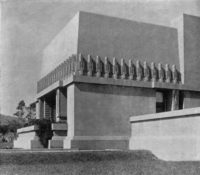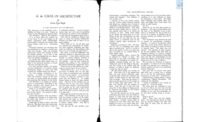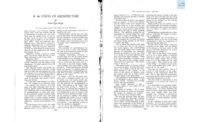The more serious side and the occasion for this second paper is the fact that emboldened or befooled by its measure of “Success,” the new work has been showing weaknesses instead of the character it might have shown some years hence were it more enlightened and discreet, more sincere and modest, prepared to wait, to wait to prepare.
The average American man or woman who wants to build a house wants something different – “something different” is what they say they want, and most of them want it in a hurry. That this is the fertile soil upon which an undisciplined “language speaking” neophyte may grow his crop to the top of his ambition is deplorable in one sense, but none the less hopeful in another and more vital sense. The average man of business in America has truer intuition, and so a more nearly just estimate of artistic values, when he has a chance to judge between good and bad, than a man of similar class in any other country. But he is prone to take that “something different” anyhow; if not good, then bad. He is rapidly outgrowing the provincialism that needs a foreign-made label upon “Art,” and so, at the present moment, not only is he in danger of being swindled, but likely to find something peculiarly his own, in time, and valuable to him, if he can last. I hope and believe he can last. At any rate, there is no way of preventing him from getting either swindled or something merely “different”’ nor do I believe it would be desirable if he could be, until the inorganic thing he usually gets in the form of this “something different” is put forward and publicly advertised as of that character of the young work for which I must feel myself responsible.
I do not admit that my disciples or pupils, be they artists, neophytes or brokers, are responsible for worse buildings than nine-tenths of the work done by average architects who are “good school” – in fact, I think the worst of them do better – although they sometimes justify themselves in equivocal positions by reference to this fact. Were no more to come of my work than is evident at present, the architecture of the country would have received an impetus that will finally resolve itself into good. But to me the exasperating fact is that it might aid vitally the great things we all desire, if it were treated on its merits, used and not abused. Selling even good versions of an original at second hand is in the circumstances not good enough. It is cheap and bad – demoralizing in every sense. But, unhappily, I have to confess that the situation seems worse where originality, as such, has thus far been attempted, because it seems to have been attempted chiefly for its own sake, and the results bear about the same resemblance to an organic architecture as might be shown were one to take a classic column and, breaking it, let the upper half lie carelessly at the foot of the lower, then setting the capital picturesquely askew against the half thus prostrate, one were to settle the whole arrangement as some structural feature of street or garden.
For worker or broker to exhibit such “designs” as efforts of creative architects, before the ink is yet dry on either work or worker, is easily done under present standards with “success,” but the exploit finally reflects a poor sort of credit upon the exploited architect and the cause. As for the cause, any growth that comes to it in a “spread” of this kind is unwholesome. I insist that this sort of thing is not “new school,” nor this the way to develop one. This is piracy, lunacy, plunder, imitation, adulation, or what have you will; it is not a developing architecture when worked in this fashion, nor will it ever become one until purged of this spirit; least of all is it an organic architecture. Its practices belie any such character.
“Disciples” aside, some fifteen young people, all entirely inexperienced and unformed – but few had even college educations – attracted by the character of my work, sought me as their employer. I am not teacher; I am a worker – but I gave to all, impartially, the freedom of my work room, my work and myself, to imbue them with the spirit of the performances for their own sakes, and with the letter for my sake so, so that they might become useful to me; because the nature of my endeavor was such that I had to train my own help and pay current wages while I trained them.
The nature of the profession these young people were to make when they assumed to practice architecture entails much more careful preparation than that of the “good school” architect; theirs is a far more difficult thing to do technically and artistically, if they would do something of their own. To my chagrin, too many are content to take it “ready made,” and with no further preparation hasten to compete for clients of their own. Now fifteen good, bad and indifferent are practicing architecture in the Middle West, South and Far West, and with considerable “success.” In common with the work of numerous disciples (judging from such work as has been put forward publicly), there is a restless jockeying with members, one left off here, another added there, with varying intent – in some a vain endeavor to reindividualize the old types; in others an attempt to conceal their origin, but always – ad nauseam – the inevitable reiteration of the features that gave the original work its style and individuality. To find fault with this were unfair. It is not unexpected nor unpromising except in those unbearable cases where badly modified inorganic results seem to satisfy their authors’ conception of originality; and banalities of form and proportion are accordingly advertised in haste as work of creative architects of a “new school.” That some uniformity in performance should have obtained for some years is natural; it could not be otherwise, unless unaware I had harbored marked geniuses. But when the genius arrives nobody will take his work for mine – least of all will he mistake my work for his.
“The letter killeth.” In this young work at this time, still it is the letter that killeth, and emulation of the “letter” that gives the illusion or delusion of “movement.” There is no doubt, however, but that the sentiment is awakened which will mean progressive movement in time. And there are many working quietly who, I am sure, will give a good account of themselves.
Meanwhile, the spirit in which this use of the letter has its rise in important to any noble future still left to the cause. If the practices that disgrace and demoralize the soul of the young men in architecture could be made plain to him; if he could be shown that inevitably equivocation dwarfs and eventually destroys what creative faculty he may possess- that designing lies, in design to deceive himself or others, shuts him out absolutely from realizing upon his own gifts – no matter how flattering his opportunities may be – if he could realize that the artist heart is one uncompromising core of truth in seeking, in giving or in taking – a precious service could be rendered him. The young architect who is artist enough to know where he stands and man enough to use honestly his parent forms as such, conservatively, until he feels his own strength within him, is only exercising an artistic birthright in the interest of a good cause – he has the character at least from which great things may come. But the boy who steals his forms – “steals” them because he sells them as his own for the moment of superficial distinction he gains by trading on the results – is no artist, has not the sense of the first principles of the ideal that he poses and the forms that he abuses. He denies his birthright, an act characteristic and unimportant; but for a mess of pottage, he endangers the chances of a genuine forward movement, insults both cause and precedent with an astounding insolence quite peculiar to these matters in the United Stets, ruthlessly sucks what blood may be left in the tortured and abused forms he caricatures and exploits – like the parasite he is.








Post a comment to this article
Report Abusive Comment